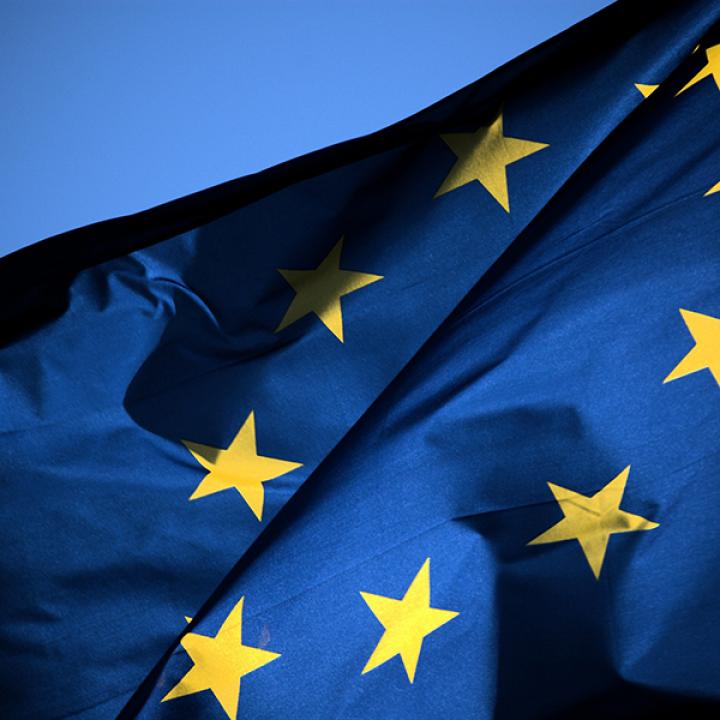
- Policy Analysis
- PolicyWatch 3242
Europe Is Creating an Opportunity for Iran Talks, and Washington Should Take It

By triggering the nuclear deal’s dispute resolution mechanism, Britain, France, and Germany are opening diplomatic space that could help the United States and Iran return to the negotiating table.
In a press conference following the assassination of Qasem Soleimani, President Trump reaffirmed his administration’s “maximum pressure” policy against Iran and asked, once again, for European countries to leave the nuclear deal. Meanwhile, Tehran announced what it called a “fifth and final remedial step” away from its commitments under the Joint Comprehensive Plan of Action. In response, the British, French, and German foreign ministers stated on January 14 that they would trigger the JCPOA’s dispute resolution mechanism (DRM).
At the same time, however, the E3 clarified that they are not joining the Trump administration’s maximum pressure campaign, which has steadily intensified ever since the United States withdrew from the JCPOA and reimposed unilateral sanctions in 2018. Contrary to U.S. claims, the European decision will not immediately provoke “snapback” UN sanctions on Iran (though that scenario could unfold later if the E3 plan fails and Iran’s violations go before the UN Security Council). Instead, Europe is maintaining its evenhanded position somewhere between Washington and Tehran in order to preserve the possibility of new negotiations, on both the nuclear program and other regional issues.
THE LONG MARCH TO THE DRM
The E3 have sought to withhold the DRM option as their last resort since May 2019, when Iran began to withdraw from certain JCPOA commitments in three-month intervals. Tehran’s strategy was sparked by the Trump administration’s escalating pressure—that same month, the United States canceled a waiver that had allowed the Iranians to sell their enriched uranium, essentially forcing them to either stop enrichment altogether or exceed the JCPOA limits. They chose the latter path, and have taken other “remedial steps” since then: exceeding the stockpile limits on heavy water; enriching uranium to higher levels; disregarding restrictions on centrifuge R&D; resuming enrichment at the highly fortified Fordow facility; and increasing the number of operational centrifuges, including advanced models.
The latest step, announced on January 5, suggests that Iran will no longer abide by any technical limits on its centrifuges. This would allow it to increase the amount of enriched uranium it produces each month, substantially lowering the amount of time it would need to “break out” to weapons-grade material if it chose to take that path. Indeed, on January 16, President Hassan Rouhani stated that his country was producing more enriched uranium today than before the JCPOA—a disturbing claim given how short its estimated breakout time was in 2015 (for more on Rouhani's statement, see the technical companion piece to this PolicyWatch). The next report by the International Atomic Energy Agency, due in early February, will shed light on exactly how much Iran is ramping up its technical capacity.
Fortunately, Tehran has not used the nuclear portfolio to punish the United States for Soleimani’s assassination. Although he was killed just two days before the January 5 centrifuge announcement, that “fifth remedial step” had been expected well before then. Tehran’s relative restraint is likely rooted in its eagerness to remain in the JCPOA, since it still receives important benefits from doing so—in particular, avoiding the reinstatement of certain EU and UN sanctions. In the longer term, the Iranians may aim to wait out Trump, perhaps hoping that a new president will replace him next year and reenter the JCPOA. In the meantime, they can start selling weapons again this October, when various UN restrictions on such activity expire.
TRIGGERING THE DRM IS A NECESSARY RISK
Over the past few months, the United States repeatedly asked European leaders to acknowledge Iran’s noncompliance with the JCPOA by engaging the DRM, but they were hesitant to do so until now. In their view, the JCPOA is the only viable framework to prevent Iran from obtaining nuclear weapons, so they have given Tehran every chance to come back into full compliance. Triggering the DRM is not without risks, since failure could collapse the JCPOA altogether, spark new escalation in the region, and make future U.S. talks even less likely. Yet European officials seem to believe that taking this step now is crucial because competing U.S. and Iranian pressures have already put the nuclear deal in a perilous position. The DRM is also their best option for preserving the E3’s credibility and avoiding further military escalation.
Accordingly, after Iran made its centrifuge announcement on January 5, the E3 reaffirmed their commitment to the JCPOA, restated their goal of preventing the country from acquiring nuclear weapons, and blamed Tehran for stoking regional instability. They then triggered the DRM, a flexible process that allows any JCPOA party to refer an issue to the Joint Commission for resolution if it believes another party is failing to meet its commitments. All of the parties—Britain, China, France, Germany, Iran, Russia, and the EU—now have approximately one month to decide how to deal with Tehran’s violations (or longer if they agree on an extension).
This is an opportunity that Iran and the United States should seize if they want to avoid further escalation. European leaders are hoping that Tehran’s desire to remain in the JCPOA will force it to compromise during the DRM process. This could lay the foundation for new Iranian negotiations with Washington, initially based on salvaging the JCPOA framework, then broadening to encompass other issues. Yet this approach will only work if the Trump administration provides realistic options that Europe can present as grounds for getting everyone back to the table.
RESUMING TALKS: WHY AND HOW?
The United States and Europe agree that Iran’s activities in Iraq, Syria, and Yemen pose a threat to regional security and should be on the table, as should its ballistic missile program. French president Emmanuel Macron has taken a number of steps to resume talks based on those mutual interests, even convincing Trump and Rouhani to agree on a four-point plan at the UN General Assembly last September. Yet a string of escalatory incidents, including a militia riot at the U.S. embassy in Iraq, the killing of Soleimani, and Iran’s retaliatory missile attack, have made it difficult to convert those steps into a negotiation.
In addition, the outbreak of new protests in Iran has led some to argue that now is not the time to pursue talks with the government. This contention is short-sighted, however—it is entirely possible to support the aspirations of demonstrators while simultaneously preparing for serious negotiations. Exploring diplomatic avenues is not contradictory to expressing solidarity with local calls for transparency, democracy, and better governance; in fact, negotiations would send a message to Iranians that their government has other options besides further militarization.
President Trump has repeatedly indicated that he is in favor of making a deal with Iran, and the E3 are counting on him to act accordingly. Now that the DRM has been activated, Washington should use the resultant pressure on Iran to make additional proposals and open space for negotiations that go beyond the nuclear issue. Europe has always regarded the nuclear deal as the first indispensable pillar of a larger deal with Iran, and the DRM is an opportunity for the United States to build toward the latter instead of tearing down the former. For example, if the Trump administration offers limited new sanctions waivers during the DRM process, it would not only help European officials in bringing Iran back to the table, but also send a message that the goal of the maximum pressure campaign is new talks, not regime change—a crucial element of pre-negotiation confidence-building.
Some perceive the DRM decision as an instance of Europe caving in, whether to Washington or Tehran. In terms of its actions over the past two years, however, Europe has stayed united and fairly consistent in mediating between the two sides, so it is now up to the U.S. and Iranian governments to meet the E3 halfway. So far, unfortunately, they have lashed out at Europe’s choice, with the Trump administration calling for Europe to reimpose sanctions instead of the DRM, and the Rouhani government threatening European soldiers abroad.
European countries have long warned that U.S. withdrawal from the JCPOA would weaken counterproliferation efforts, strengthen Iran’s Islamic Revolutionary Guard Corps, and fuel regional instability. In their view, those predictions have come true, so it is now time to get serious about negotiations and stop the uncontrolled game of countermeasures. Although the DRM is no magic pill, Iran and the Trump administration need to realize that there are few if any good options left for reaching a negotiated solution.
Elana DeLozier is a research fellow in The Washington Institute's Bernstein Program on Gulf and Energy Policy.



